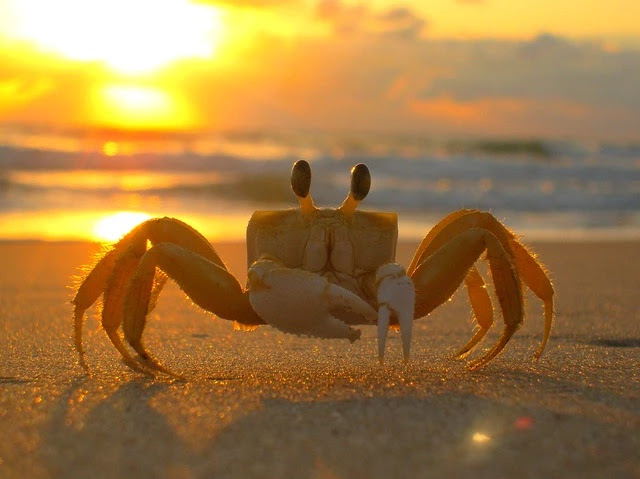Scary Facts About Crabs
- There are more than 4,500 species of crabs.
- Most species live in coastal areas of salty, fresh, or brackish water.
- The crabs are super old! They showed up during the Jurassic period, 200 million years ago.
- The Pea Crab is the smallest known species. It measures between 0.27 and 0.47 inches long.
- The Japanese Spider Crab is the biggest, measuring about 12 feet between its claws!
- Crabs have an “exoskeleton” made of chitin. It protects their soft tissue.
- March 9th is National Crabmeat Day.
- September 25th is National Crab Newberg Day.
- The lifespan of crabs is in the range of 8 to 13 years.
- Babies of crabs are called hatchlings.
- A crab’s teeth are in its stomach.
- Crabs walk and swim sideways.
- Robber crabs are capable to climb trees and they can fall at least 15 feet without being hurt.
- Decapod means "ten-footed". Crabs have 10 legs, however, the first pair are its claws which are called chelae.
- Crabs have a thick external skeleton called an exoskeleton. It is a shell made of calcium carbonate and provides protection for the soft tissue underneath.
- Other animals with similar names such as hermit crabs, king crabs, porcelain crabs, horseshoe crabs, and crab lice, are not true crabs.
- Males have larger claws than female crabs. The females’ abdomen is wide and round compared to the slender abdomen of males.
- Bromeliad crab mothers are some of the most caring around―even placing old snail shells in the water around their babies to boost calcium intake.
- Crabs can be right-handed, left-handed, or ambidextrous.
- If a male Australian fiddler crab’s burrow is being invaded by an intruder looking to take over the burrow, his male neighbor will leave his own burrow to help fight off the intruder.
- Two neighboring crabs will never fight each other.
- Sadly, every year fishers in the United States kill hundreds of millions of crabs.
- Fishers use several methods to catch crabs, including setting traps in shallow water and dragging huge nets along the ocean floor.
- These methods also capture birds, fish, and other marine animals who are thrown back into the water often after they are already dead or dying.
- Despite their exposure through animation, little is actually known about these mysterious crustaceans.
- But we do know a few things, like how crabs learn from their mistakes.
- And they’re notorious neat freaks.
- Crabs are omnivorous species and they predominantly feed on algae.
- The biggest crab in Maryland was a male which measured 9 in. Crabs are omnivorous species and they predominantly feed on algae.
- The biggest crab in Maryland was a male which measured 9 in.
- Crabs can be all different colors―from bright red to bright blue.
- They can also be all different sizes―from 1 centimeter to 13 feet.
- Crabs, who are naturally territorial, are crowded together in holding containers while they await their fate.
- Those crabs unlucky enough to reach the slaughterhouse alive are sometimes dismembered while completely conscious, like at Linda Bean’s Maine Lobster.
- Pregnancy in female crabs only last one or two weeks. Then they lay between 1,000 and 2,000 eggs!
- Groups of crabs living together are known as “casts.”
- Crabs are decapods from the crustacean family.
- Crabs usually have a distinct sideways walk. However, some crabs can walk forwards or backward, and some are capable of swimming.
- Crabs communicate with each other by drumming or waving their pincers.
- Male crabs tend to often fight with each other over females or hiding holes.
- The Pea Crab is the smallest known species at just a few millimeters wide. The largest species is the Japanese Spider Crab, with a leg span of up to 4 m (13 ft).
- Crabs are omnivores (meaning they eat both meat and plants), they feed mainly on algae, but also bacteria, other crustaceans, mollusks, worms, and fungi.
- Some crab species can naturally autotomize (shed) limbs such as their claws, which then regenerate after about a year.
- Of all marine crustaceans caught by humans each year, crabs make up 20%. This adds up to a total of 1.5 million tonnes annually.
- The most consumed species of crab in the world is the Japanese Blue Crab.
- Everybody knows that crabs are BFFs with mermaids and have Jamaican accents, but there might be even MORE to them than that.
- There, crabs’ exposed internal organs are scrubbed off by spinning brushes.
- Then they are lowered into boiling water. When they hit the water, they are still alive.
- Crabs are found in almost all the oceanic waters of the world. True crabs, of which about 4,500 species are extensively distributed worldwide.
Friends, hope you liked this post of Scary Facts About Crabs. If you liked this post, then you must share it with your friends and Subscribe to us to get updates from our blog. Friends, If you liked our site FactsCrush.Com, then you should Bookmark it as well.














0 Comments